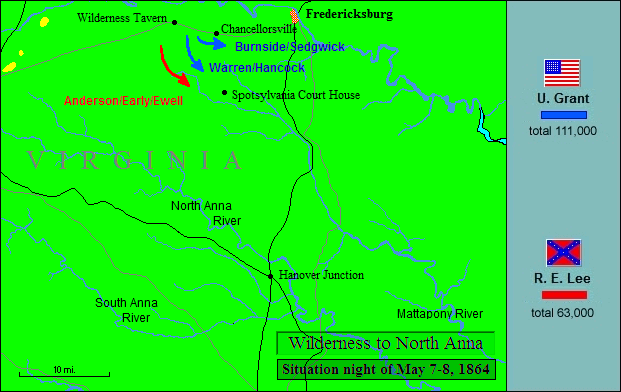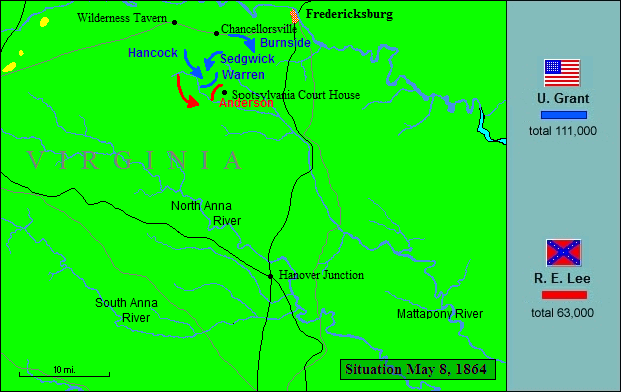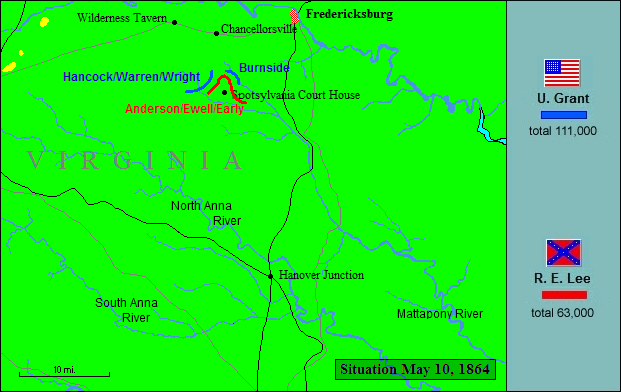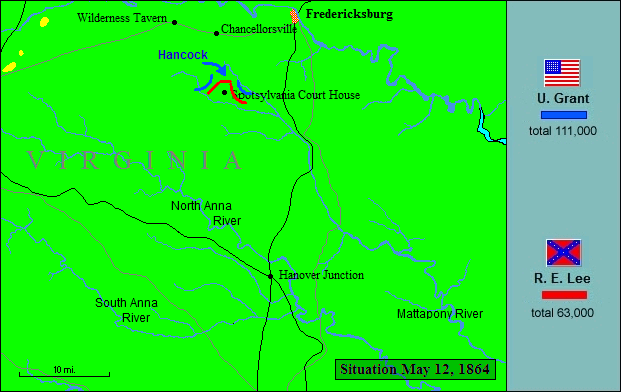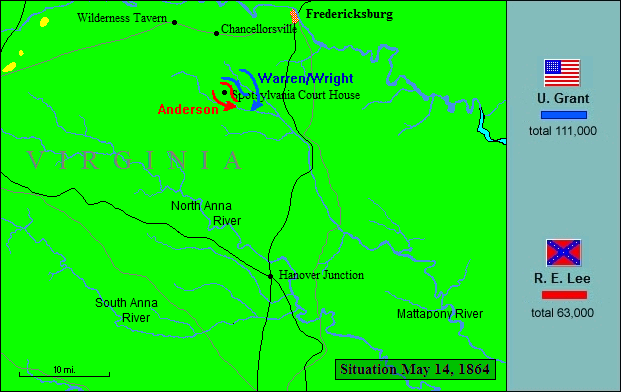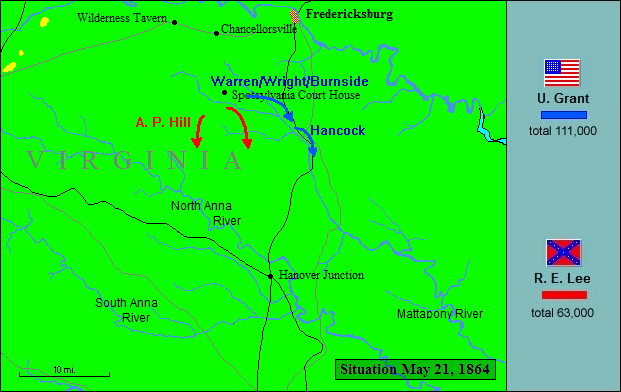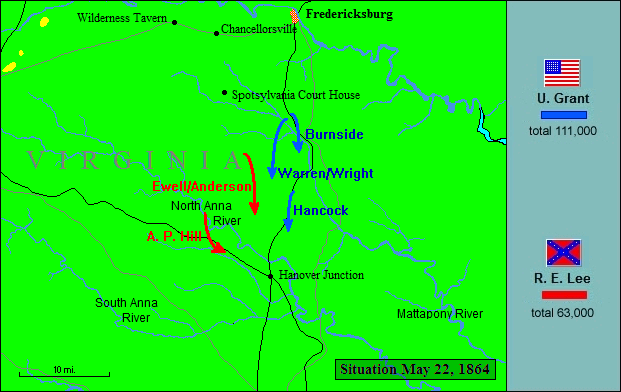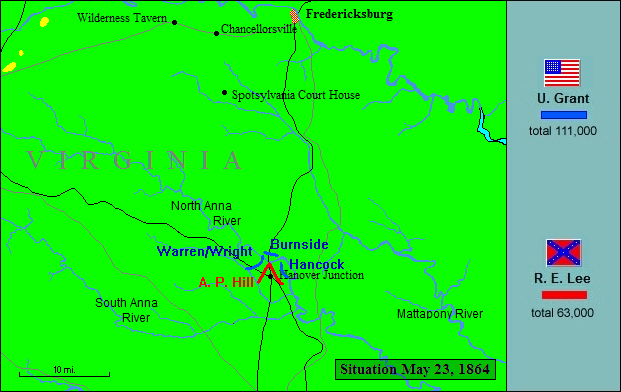I propose to fight it out on this line if it takes all summer.
–Ulysses S. Grant
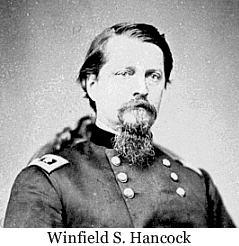
Lee had urgent need of every rider and every man who could carry a musket just then, for Grant’s effort to turn Lee’s right was going to be relentless. In a wire to Washington, Grant declared: “I propose to fight it out on this line if it takes all summer.” In the lead of Grant’s advance, Warren’s V Corps now ran a desperate race with Dick Anderson’s two divisions, a punishing nine-mile night march on short rations after two days of battle. Anderson, now commanding the I Corps for the wounded Longstreet, won the race by a hair’s breadth, and soon had a line of breastworks squarely across the Brock Road north of Spotsylvania strong enough to beat back three Federal assaults on the afternoon of May 8. This battle was just the bloody beginning of ten days of continuous savage combat at Spotsylvania. By this fourth year of war, the private soldier was as canny an engineer as the best West Pointer, and the works the Rebels threw up at Spotsylvania were formidable. Grant thought at first he might flank Lee out of his trenches, sending Hancock’s II Corps swinging right to strike Lee’s left, but by the time Hancock got in position to attack on the 10th, Lee had shifted strength to that sector and turned him back. If Lee had reinforced his left, Grant reasoned, his smaller army must be vulnerable elsewhere. On the afternoon of the 10th, he tried a massive assault, five divisions on a mile-wide front on Lee’s left-center. But veteran riflemen behind strong works kept up a murderous fire, and again Lee shifted strength, this time from his right, to meet the threat.
The only real Federal success in the day’s fighting occurred in the center. There the Rebel lines ran in a wide half-circle jutting out toward the Federals across the way, the Mule Shoe men called it. Among the bluecoats opposite was a youthful West Pointer, Colonel Emory Upton, who thought he knew how to solve the problem of attacking entrenched positions. The rifled musket and the Minie ball had increased the killing range of massed musketry three-fold over the smoothbores of the Mexican War, and at ranges up to three hundred yards veteran riflery was lethally effective. Upton believed that reducing the attacking force’s time of exposure to musket fire increased its chances of success. In essence, the idea was to overwhelm the enemy in a rush rather than try to shoot it out with him. His theory would be put to the test against the west face of the Mule Shoe salient, where he formed up twelve crack regiments in four lines and sent them on a dead run against the Rebel works. Under orders not to stop or fire a shot until they were on the enemy, the first line pierced the Rebel trenches and, pushing both right and left, secured a breach. The second line kept driving for the Confederates’ second line a hundred yards in the rear. Then the third and fourth lines came up breathlessly and bagged a thousand prisoners. It was a handsome piece of work for young Upton. Unfortunately for him, however, the division assigned to support and exploit this success did not make a very determined attack and was turned back by artillery fire. Isolated on the Rebel line without support, Upton’s men were themselves turned back by a fierce Confederate counterattack and made their way back to their own lines in the twilight as best they could. Although a great opportunity had been squandered, Grant liked the idea of a swiftly delivered massive attack on a narrow front. A division today, he said, a corps tomorrow.
The corps he planned to strike with was probably the best in his army, Hancock’s II Corps, and the objective would again be the Mule Shoe, the center of Lee’s long half-circle of trenches. In this effort Hancock would have the advantage of a rare miscalculation on the part of Robert E. Lee. Learning that Yankee wagons were in motion to the rear, Lee supposed that Grant had had enough on this front and was preparing to swing once more to his left. Accordingly, Lee prepared to move as well, ordering 22 guns to be sent from the apex of the salient to his own rear. That apex, however, was precisely the angle Hancock struck with savage force at dawn of May 12. Driving through the mist of a rainy morning, the 15,000 men of II Corps overwhelmed the first line of Rebel trenches, incidentally capturing the 22 guns that Lee had sent back at the last moment. They pushed on furiously another half mile, taking nearly the whole of the Stonewall Division prisoner. With a hole punched in Lee’s center, Warren’s corps pitched in on the Federal right and Burnside’s on the left. When Horatio Wright brought up the VI Corps on Hancock’s right to lend its weight to the attack, it seemed the road to Richmond was open at last. (Wright now commanded in Sedgwick’s stead. Uncle John had been shot dead with a ball in his brain at the very moment he was assuring his staff that the Rebels “couldn’t hit an elephant at this distance.”) At the angle now–forever after the Bloody Angle–was Robert E. Lee with a reserve division. As he had in the Wilderness less than a week before, Lee, at the moment of crisis, intended to lead the counterattack himself. But that notion was as unthinkable to John B. Gordon and his men as it had been to the Texans in the Wilderness. Gordon called out: “General Lee, you shall not lead my men in a charge… These men behind you are Georgians, Virginians, Carolinians. They have never failed you on any field. They will not fail you here.” From the ranks now rose a recurring shout, “General Lee to the rear! General Lee to the rear!” Gordon thought that, had it been necessary, the men would have carried horse and rider both on their shoulders to the rear.
The shock of the Rebel counterattack drove Hancock’s men back to the first line of trenches where they rallied. Now blew up a storm of savagery unlike anything since the battle madness that had turned the landscape red at Antietam. The contending lines were locked in combat just a few yards apart, attacking and counterattacking by turns in the rainy, bloody mire. “Rank after rank was riddled by shot and shell and bayonet thrusts,” General Horace Porter remembered, “and finally sank, a mass of torn and mutilated corpses.” Men in the rear ranks passed bayoneted rifles forward where men would leap on the parapet with them, shoot down on their foes, then hurl them like spears until they were shot down or bayoneted themselves. So furious was the musketry that in one place an oak two feet in diameter was toppled by Minie balls. (In a place where so many men perished, nearly every survivor remembered that tree cut down by rifle fire.) As a general thing, when fighting comes to close quarters, one side or another breaks. But at the Bloody Angle both sides fought on in the rain, eighteen mortal hours of agony. Although well after dark Lee sent orders to pull his men back to a hastily engineered line a half-mile to the rear, the fighting did not sputter out until midnight. Twelve thousand men had been shot or stabbed contesting a square mile of ground. The next day’s dawn revealed, Horace Porter remembered, “the enemy’s dead… piled upon each other in some places four layers deep… Below the mass of fast-decaying corpses, the convulsive twitching of limbs showed that there were wounded men still alive.” Grant’s overland campaign was just seven days old. From the first collision in the Wilderness on the 5th to the endless 12th of May at Spotsylvania, he numbered 32,000 dead, wounded, and missing. Lee’s smaller army counted 18,000 casualties. Attrition in the Confederate officer corps was especially heavy. Longstreet and Stuart were just two of twenty general officers out of action. One wonders if any of the survivors recalled that confident belief from the ancient days of Sumter: a lady’s thimble would hold all the blood shed in this conflict.
Still, the fighting at Spotsylvania was not yet finished. During the next week, Grant struck both flanks and tried once more to crush Lee’s center with an attack there, but he succeeded only in lengthening the casualty lists on both sides. In two weeks both armies were in a sense being wrecked and remade as the men who began the campaign steadily filled the nation’s hospitals, prisons, and cemeteries. Filling the ranks of the fallen in Grant’s army were recruits from throughout the North as well as men of the “heavies” from Washington. These latter had been doing comfortable and safe duty manning the forts and heavy artillery that defended Washington. Now, to the infinite delight of the veterans, Grant was making infantrymen of them. Lee’s army was stiffened by eight brigades of veterans, six from Richmond and two from the Valley. As one Federal colonel, Washington Roebling, grimly confided to his diary a little later that summer, “the demand down here for killing purposes is far ahead of the supply.”

